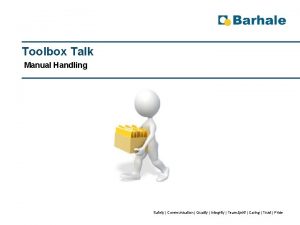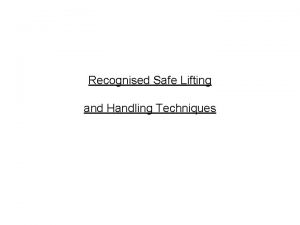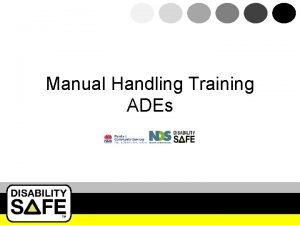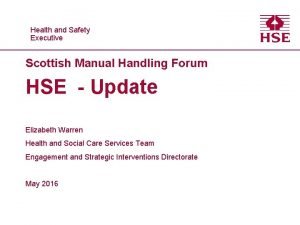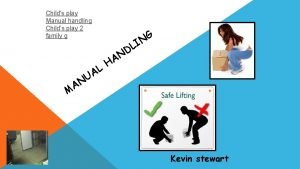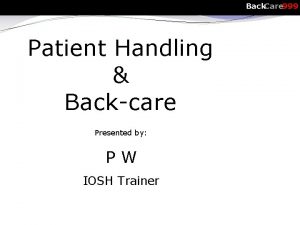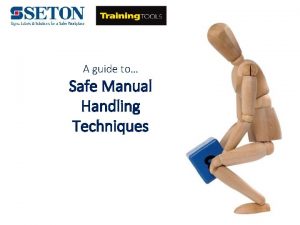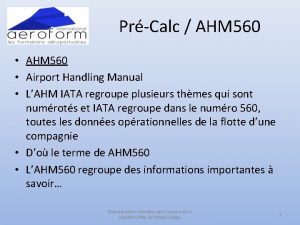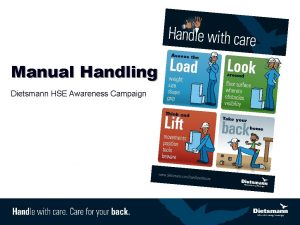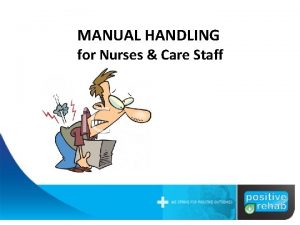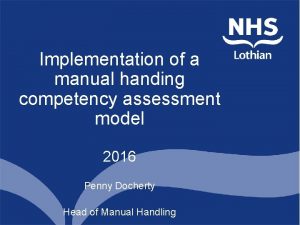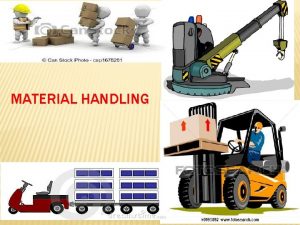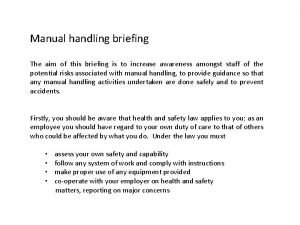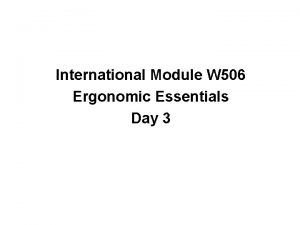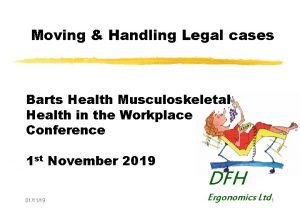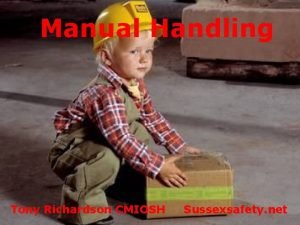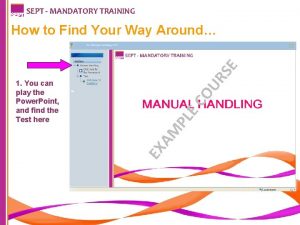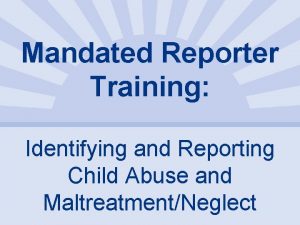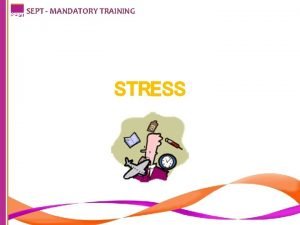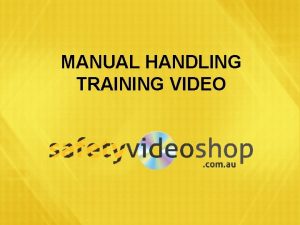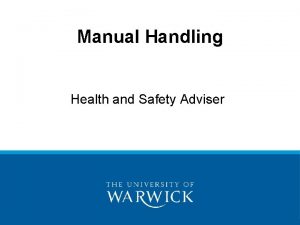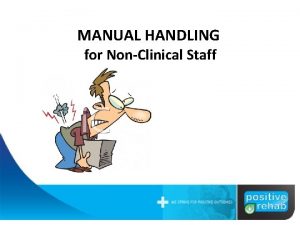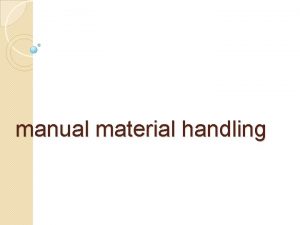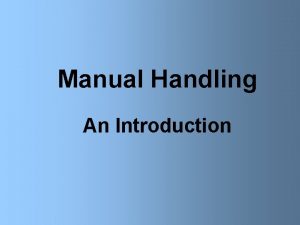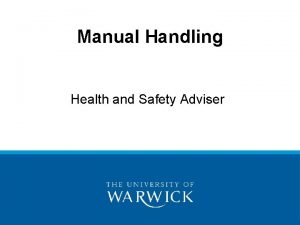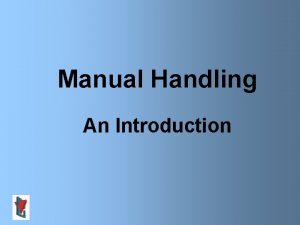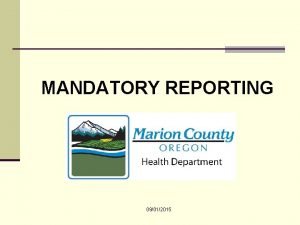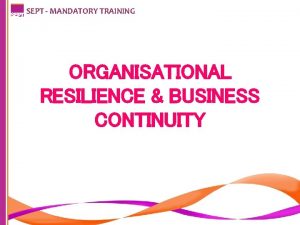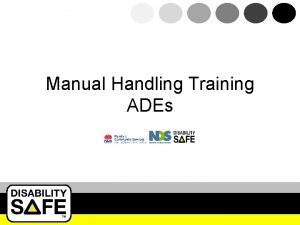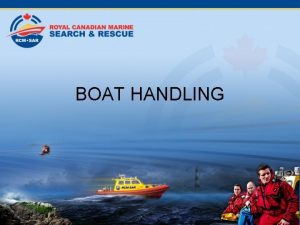SEPT MANDATORY TRAINING MANUAL HANDLING SEPT MANDATORY TRAINING




















- Slides: 20

SEPT - MANDATORY TRAINING MANUAL HANDLING

SEPT - MANDATORY TRAINING Basic Back Care Theory Update Course Contents You can complete this course in more than one session and use the menu on the left of this page to navigate to the last page you viewed. This course covers the following topics: • Definitions • Health and Safety law as applied to manual handling • The risk assessment process in manual handling - a structured approach to minimising risk • An overview of the structure and function of the spine • Advice on how to keep your back safer when moving and handling • The unsafe ways of assisting clients.

SEPT - MANDATORY TRAINING Statistics Manual handling injuries account for approximately 30% of all general workplace reported injuries and almost 50% of reported injuries by care workers who assist clients to move. However, these only represent the tip of a very large pyramid. For each injury reported it is estimated that there are 10 additional injuries that are not reported and approximately 200 near misses. Remember that moving and handling people presents the highest risk of injury, far higher than any other group of workers including those people working in construction and agriculture. What does the law say we must do about the risk of harm associated with manual handling? This is covered by the Health and Safety at Work Act 1974 which aims to make the workplace as safe as reasonably possible for staff and anyone affected by their work. But because there are so many different types of work being done in workplaces across the UK, the Act sits on top of many individual regulations each one directed at different hazards within the workplace - for example the Control of Substances Hazardous to Health (COSHH) 2002 etc. The purpose of legislation is to reduce risk exposure and target risk factors in order to minimise the risk of injury. Central to this course is the Manual Handling Operations Regulation 1992. The other regulations shown below are also relevent to Manual Handling.

SEPT - MANDATORY TRAINING Law - Manual Handling Operations Regulation 1992 The regulation aims to eliminate or reduce the risk of injury when moving and handling to the lowest level reasonably practicable. The steps that have to be taken are, in order: Avoid. (the need for manual handling if possible). For example can we avoid the need to manual handle by rearranging the task or using equipment? Assess. All the manual handling tasks that cannot be avoided must be properly assessed. Reduce. Clearly it is not enough just to do a risk assessment. Based on the assessment we must ensure that the risk of injury is reduced for staff and clients. How much does it need to be reduced? It must be reduced so far as is reasonably practicable (SFAIRP). Review. The risk assessment must be written down in the client moving and handling plan in sufficient detail to make the system of work clearly understandable. But change happens over time. The environment may change, the client may change, staff may change. Therefore the risk assessment must be reviewed to reflect these changes. Not only that, even if no changes happen the assessment must still be periodically updated at regular and scheduled intervals. This can be summarised as follows.

SEPT - MANDATORY TRAINING What are our responsibilities as members of staff? Once the risk assessment has been done we need to follow the safe system of work as laid down in the moving and handling plan. If any changes occur that make the moving and handling plan no longer current and applicable, this must be reported immediately to the responsible person. Risk Assessment - hazard and risk Central to understanding the risk assessment process is the difference between a hazard and a risk. In everyday language these terms are used to express the same thing. For example, 'that was hazardous' and 'that was risky'. In risk assessments however they have distinct and different meanings. A hazard is anything that has the potential to cause harm. Trailing leads, confined spaces, water on the floor are all examples of a hazard. A risk is the chance or probability of harm occurring from a hazard and takes into account the likely seriousness of the injury or incident should it occur.

SEPT - MANDATORY TRAINING Risk Assessment - TILEE We often undertake risk assessments in everyday life, for example driving a car and crossing a road. These assessments are of course informal, not structured and certainly not written down! When completing a manual handling risk assessment it is useful to have a structured approach so that hazards are easier to see and risks are easier to control. In manual handling the risk assessment must consider the hazards and risks in the following areas: Where: The Task is the purpose of the manual handling, i. e. what is being done. Examples of client manual handling tasks are - standing, sitting, walking, getting into bed, turning in bed and personal care. • The Individual is the member(s) of staff assisting the client to move. • The Load is the client who is being assisted to move. • The Environment - is the space in which the client is being moved. • The Equipment - is the available equipment.

SEPT - MANDATORY TRAINING Risk Assessment - The Task • • • Things (risk factors) to consider about the Task How is the task currently performed? What postures and movements are required? How long does the task take? Does it involve twisting, or bending? Does it require you to reach upwards or forwards? When and how often is it done? Is there sufficient rest between this task and the next? Does the task take a long time to complete and is there sufficient rest between tasks? Risk assessment - The Individual (you and me!) • • • Just because most people can undertake a task safely does not mean that everyone can do so. You must consider whether it is safe for you to do the task. Things to consider about yourself Are you fit enough to do the task or do you have an injury or a medical condition that might put you at excessive risk of injury or prevent you from applying best practice techniques? Are you pregnant and does the pregnancy mean that this particular manual handling task is an excessive risk? Are you trained and even with training are you confident that you have the knowledge to undertake this particular task? Have you read the client's moving and handling plan or are you undertaking the task with someone who is familiar with it? How well do you know the client and do you know how they might react to a given situation. ? Do you know them well enough to maximise their level of cooperation? Are you familiar with any equipment used in the workplace to assist the client? If in doubt always seek advice.

SEPT - MANDATORY TRAINING Risk Assessment - The Client Things to consider about the client - Clients are not like inanimate loads; they may be unpredictable and move unexpectedly, they may be floppy or difficult to grasp. In addition clients, like everyone else, can and are likely to have changes in mood depending on many factors. The following list is not meant to be exhaustive but includes some factors relating to clients that need to be taken into account during a risk assessment: • apprehension or fear of being moved • degree of cooperation • ability to understand communicate • behaviour • sensory impairment • pain • tissue viability • medication • weight • type of clothing For example: Clothing - tightly fitted non-elastic clothing will increase the risk when assisting a client with dressing. Different clothes or making adaptations such as Velcro seams can reduce the effort and risks and is appropriate for some clients based on the assessment. Pain - pain relief and manual handling should be coordinated. Ability to understand communicate - communication with clients should always be specific to that individual and be at appropriate level in terms of content, speed, pitch etc.

SEPT - MANDATORY TRAINING Risk Assessment - The Working Environment Things to consider in the Environment • • • Is there enough space for the task? Is there enough space for the client, for you and your colleagues and all the equipment you may need to use? Are there problems in the design of the environment? Are the doorways and corridors too narrow or is the shape of the environment awkward? Is there anything on the floor that you or your client might slip or trip on? Slide sheets are particularly high risk slip hazards. Is it too hot or too cold which might impair your grip or cause fatigue? Is your environment very busy, noisy or distracting? Equipment Does the Task require specific equipment, for example a height adjustable profiling bed or slide sheets? Is the equipment safe and is it maintained? Is everyone trained in using the equipment and also does everyone know how to use the equipment?

SEPT - MANDATORY TRAINING Moving and Handling Forms 1. The Individual Client Risk Assessment and Action Plan lays out in detail the risk assessment process (T. I. L. E. E. ) and is completed when a more detailed structure is required to complete the client assessment. This would be in more complex situations where the method of transfer is not easily apparent. If you are using a computer on the Trust intranet you can view the complete document here. 2. The Client Moving and Handling Plan is used to record the safe system of work resulting from the risk assessment. If you are using a computer on the Trust intranet you can view the form here. Provision and Use of Work Equipment Regulation (PUWER) 1998 Equipment is often used to assist clients to move and these must be fit for purpose. What work equipment is covered? Generally any equipment which is used at work, for example; beds, patient hoists, slide sheets and rota stands. What are the requirements? it must be suitable for the intended purpose it must be safe for use and maintained in a safe condition it must be used by people who have received adequate training and instruction to use it safely it must be fitted with adequate guards and warning signs where appropriate. A simple guide to PUWER 1998 can be found on the Health and Safety Executive website at this link

SEPT - MANDATORY TRAINING Law - Human Rights Act 1998 Before leaving the law it is important to note that clients also have rights including those laid down in the Human Rights Act 1998 which is based on the European Convention on Human Rights. The relevant articles of the Convention are: Article 2 - The right to life Article 3 - Inhuman treatment. No one shall be subjected to torture or to inhuman or degrading treatment or punishment. Article 8 - The right to privacy. Everyone has the right for his private and family life, his home and his correspondence. Anatomy The human spine consists of 32 individual bones (vertebrae) that are stacked one on top of another to form a flexible column. Viewed from the side the spine has a series of curves which act like a spring to protect our heads from the forces generated by walking and jumping. What are the different structures that form the spine? (Intervertebral) disc - Are flat, round discs that act as shock absorbers and physical spacers to separate the vertebrae to allow room for the spinal nerves to exit the spine. The discs also allow the spine to be as flexible as it is. The facet joints are paired joints at the back of the spine which direct and limit the range of movement between vertebrae.

SEPT - MANDATORY TRAINING Ligaments - are tough bands of tissue that surround the facet joints and also pass between the bodies of the vertebrae. Ligaments help limit movement and they hold everything together Spinal Muscles - like all muscles these provide the power to move bones, in this case the vertebrae. These muscles are small, delicate and weak (when compared with the large leg muscles) and form a network that runs the length of the spine. For example, any individual muscle may span one, two, three or more vertebrae which allows very fine control over the spine. These muscles are not designed for powerful work, such as bending the back to lift loads. Tendons - are non contractile bands that join the muscles to the bone. These are needed because they take up less space on the bone. The best place to see tendons is the wrist where they pass from the forearm muscles to the fingers. Anatomy Given that back injuries are common and most people will either have suffered from back pain or know someone who has, are backs really fragile and weak? Actually, far from it and a fit and healthy spine used correctly is very strong. Back injuries are so common because most people do not use their back correctly. The next page shows the correct way to use the back. When looking at it please remember that we use our backs just as much in everyday life as we do at work.

SEPT - MANDATORY TRAINING Safer Principles 1. The key safer principles of manual handling are 1. Avoid the need to do the task if it is practicable to do so. 2. Think. If it is not practicable to avoid then where necessary think and plan the task before doing it for real. For example, before hoisting a client from a bed to a wheelchair is everybody able to spend the required time without hurrying and is all the equipment immediately to hand? Is the bed at the correct height and can both sides of the bed be accessed? 3. Spine-in-line. Once you are ready to begin manual handling you should keep your back as straight as possible. This is called 'spine-in-line. It simply means avoid twisting your back or bending forwards, backwards or to the side. 4. Stable and mobile base. The feet should be placed shoulder width apart with one foot in front of the other and the knees and hips slightly bent. By using the hips and knees the need to bend the spine is reduced. 5. Load close. The load should be kept as close to the body as possible although when assisting a client this can be problematic as clients can sometimes be unpredictable in behaviour.

SEPT - MANDATORY TRAINING Safer Principles 2. In addition to the Key Safer Principles you should always try to: • Move smoothly rather than jerk • Report any concerns that you may have, for example if something within the environment prevents you from adopting these principles when moving and handling. Finally, consider how a small child would pick up a toy from the floor. A child lifts with a straight back and using the hips and knees to bend because of his lack of balance and back muscle strength but this is the way that we are 'designed' to lift. The way that most adults move, lift and handle loads and objects is essentially a learned bad habit. Controversial Techniques A number of techniques used to be used to move and handle clients but since the Manual Handling Regulation 1992 and the need to reduce the risk of injury they are now considered unsafe. These techniques are not to be used without the express agreement of the Manual Handling Advisor. The Drag Lift The Orthox Lift The Bear Hug The Top and Tail The Australian Lift

SEPT - MANDATORY TRAINING Hoisting Theory Course Welcome to Hoisting Theory Please ensure that you are in-date with your basic back care theory and familiar with the concepts before continuing. This hoisting theory course and the questions in the quiz assume this knowledge. If necessary please go back and complete that course now. Basic Principles Hoisting is a form of manual handling, i. e. it is the "transporting or supporting of a load. . . by hand or by bodily force” Manual Handling Operations Regulations (MHOR) 1992. Therefore all theory covered in the basic back care course also applies to this hoisting course. The theory in the Basic Back Care course included: • Definitions • Statistics • Law (including the need for all clients to have a manual handling risk assessment) • Anatomy and safer principles of moving and handling • The risk assessment process (Task - Individual - Load/Client - Environment - Equipment)

SEPT - MANDATORY TRAINING The Lifting Operations and Lifting Equipment (LOLER) 1998 In addition to the regulations within the Health and Safety at Work Act 1974 already covered in the Basic Back Care course, LOLER specifically covers lifting equipment such as cranes and patient hoists. As with everything in the workplace, safety is important and this regulation gives a common sense approach to maximise safety when using patient hoists. LOLER is concerned with ensuring safety when operating the hoist and requires that: • • • people using the hoist are trained and competent. The transfer is performed safely i. e. planned and organised (risk assessed and with a completed moving and plan). the equipment is strong and stable enough (marked with the safe working load, SWL). positioned and installed to minimise risk. is subject to regular (pre-use) checks. inspected and serviced by competent people. Although hoists and slings must be marked with the Safe Working Load (SWL) this information is not much help unless we also know the client's weight. Hoists and slings in our Trust are inspected by outside engineers every 6 months and are normally serviced at the same time.

SEPT - MANDATORY TRAINING Pre-use check for the hoist Before using a hoist make sure that: 1. The hoist has a service label and is within the 6 monthly service date. The label will show the date of the last service and the date the next service is due. 2. You know the safe working load (SWL) of the hoist and this should be marked on the hoist. You should also know the weight of the client, especially if they may approach the SWL of the hoist (or sling). You should also be familiar with the emergency controls (emergency lower and the emergency stop) and how to use them. Also ensure that: the battery is charged (electric hoist)? It is all too easy to forget to leave the hoist on charge when not in use with the result that the hoist might stop working during a hoist. This risk can be reduced by ward based systems and also by having a second battery on charge. • • the brakes work the wheel turn freely the hoist works (the hoist lifts/lowers and the base opens and closes). that all necessary attachments are in place the hoist is clean and hygienic there is no obvious damage - bare wires, damage to sockets. when using a liko golvo hoist check whether the belt is frayed or twisted and also whether the spreader bar is fitted with a padded jacket.

SEPT - MANDATORY TRAINING Pre-use check for the sling • Before using a sling the following checks must be made to ensure the sling is suitable and safe. • Is the sling clean and hygenic? • Is it the correct sling for the client, the hoist and the type of transfer? • Is the stitching showing signs of wear ? This usually happens where the loops attach to the body of the sling • Can you read the label? The ink is designed to fade over time with repeated washing and indicates the sling must be condemned as the fabric may have become weak. • Do you know the SWL of the sling as well as the hoist? • Is the fabric wrinkled? This usually indicates heat damage. The sling has been washed or tumbled dried at too high a temperature and must be discarded. • Disposable slings should be condemned and disposed of if they become wet. They should never be washed or cleaned.

SEPT - MANDATORY TRAINING 1. Basic Back Care: This Basic Back Care (BBC) Theory Update course is for clinical staff who have previously completed a whole day induction in BBC. It must be completed before attending any practical session or having practical techniques assessed on the ward. To complete the annual update in BBC, both theory and practical must be completed. 2. Hoisting: This hoisting update course is for staff who have previously completed a half day induction in hoisting. The course assumes knowledge of BBC and therefore you must have completed and be in date with BBC theory before taking the hoisting course. Some questions in the hoisting quiz assume this prior knowledge of BBC. This hoist theory course must be completed before attending any practical session or having practical techniques assessed on the ward. To complete the annual update in hoisting, both theory and practical must be completed.

SEPT - MANDATORY TRAINING
 Tileo stands for
Tileo stands for T.i.l.e.e manual handling risk assessment
T.i.l.e.e manual handling risk assessment What is kinetic lifting
What is kinetic lifting Lunge position manual handling
Lunge position manual handling Scottish manual handling forum
Scottish manual handling forum Manual handling childs play
Manual handling childs play The orthodox lift is:
The orthodox lift is: Manual handling positions
Manual handling positions Ahm 560
Ahm 560 Manual handling campaign
Manual handling campaign Lunge position manual handling
Lunge position manual handling Manual handling competency assessment form
Manual handling competency assessment form Definition of material handling
Definition of material handling Aim of manual handling
Aim of manual handling Manual handling
Manual handling Litee manual handling
Litee manual handling Manual handling pictures
Manual handling pictures South tees mandatory training
South tees mandatory training Mandatory training definition
Mandatory training definition Mandatory reporter training assessment answers colorado
Mandatory reporter training assessment answers colorado Un deux trois quatre cinq
Un deux trois quatre cinq
